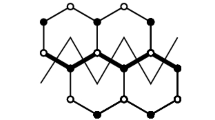Abstract
Let G be a graph with edge set E(G) that admits a perfect matching M. A forcing set of M is a subset of M contained in no other perfect matchings of G. A global forcing set of \(G\), introduced by Vukičević et al., is a subset of \(E(G)\) on which there are distinct restrictions of any two different perfect matchings of \(G\). Combining the above “forcing” and “global” ideas, we introduce and define a complete forcing set of G as a subset of \(E(G)\) on which the restriction of any perfect matching \(M\) of \(G\) is a forcing set of \(M\). The minimum cardinality of complete forcing sets is the complete forcing number of \(G\). First we establish some initial results about these two novel concepts, including a criterion for a complete forcing set, and comparisons between the complete forcing number and global forcing number. Then we give an explicit formula for the complete forcing number of a hexagonal chain. Finally a recurrence relation for the complete forcing number of a catacondensed hexagonal system is derived.




Similar content being viewed by others
References
Adams P, Mahdian M, Mahmoodian ES (2004) On the forced matching numbers of bipartite graphs. Discret Math 281:1–12
Afshani P, Hatami H, Mahmoodian ES (2004) On the spectrum of the forced matching number of graphs. Austral J Combin 30:147–160
Balakrishnan VK (1995) Theory and problems of combinatorics. Schaum’s Outline Series, McGraw-Hill
Cai J, Zhang H (2012) Global forcing number of some chemical graphs. MATCH Commun Math Comput Chem 67:289–312
Che Z, Chen Z (2011) Forcing on perfect matchings-A survey. MATCH Commun Math Comput Chem 66:93–136
Chudnovsky M, Seymour P (2012) Perfect matchings in planar cubic graphs. Combinatorica 32(4):403–424
Cyvin SJ, Gutman I (1988) Kekulé structures in benzenoid hydrocarbons, lecture notes in chemistry, vol 46. Springer, Berlin
Diestel R (2000) Graph theory, 2nd edn. Springer, New York
Došlić T (2007) Global forcing number of benzenoid graphs. J Math Chem 41:217–229
Esperet L, Kardoš F, King AD, Král D, Norine S (2011) Exponentially many perfect matchings in cubic graphs. Adv Math 227:1646–1664
Gray K (1990) On the minimum number of blocks defining a design. Bull Austral Math Soc 41:97–112
Harary F, Klein DJ, Živković TP (1991) Graphical properties of polyhexes: perfect matching vector and forcing. J Math Chem 6:295–306
Klein DJ, Randić M (1987) Innate degree of freedom of a graph. J Comput Chem 8:516–521
Kleinerman S (2006) Bounds on the forcing numbers of bipartite graphs. Discret Math 306:66–73
Lam F, Pachter L (2003) Forcing numbers of stop signs. Theor Comput Sci 303:409–416
Lovász L., Plummer M. (1986) Matching theory, annals of discrete math., Vol. 29, North-Holland, Amsterdam
Mahmoodian ES, Naserasr R, Zaker M (1997) Defining sets in vertex colorings of graphs and Latin rectangles. Discret Math 167(168):451–460
Pachter L, Kim P (1998) Forcing matchings on square grids. Discret Math 190:287–294
Randić M, Klein DJ (1985) Kekulé valence structures revisited. Innate degrees of freedom of \(\pi \)-electron couplings. In: Trinajstić N (ed) Mathematical and computational concepts in chemistry. Wiley, New York, pp 274–282
Riddle ME (2002) The minimum forcing number for the torus and hypercube. Discret Math 245:283–292
Sedlar J (2012) The global forcing number of the parallelogram polyhex. Discret Appl Math 160:2306–2313
Vukičević D, Došlić T (2007) Global forcing number of grid graphs. Austral J Combin 38:47–62
Vukičević D, Sedlar J (2004) Total forcing number of the triangular grid. Math Commun 9:169–179
Zhang H, Ye D, Shiu WC (2010) Forcing matching numbers of fullerene graphs. Discret Appl Math 158:573–582
Zhang H, Zhang F (2000) Plane elementary bipartite graphs. Discret Appl Math 105:291–311
Acknowledgments
This work is supported by NSFC (Grants No. 11001113, 61073046). The authors would like to sincerely thank the anonymous referees for the time they spent checking our proofs, as well as their many valuable suggestions.
Author information
Authors and Affiliations
Corresponding author
Rights and permissions
About this article
Cite this article
Xu, SJ., Zhang, H. & Cai, J. Complete forcing numbers of catacondensed hexagonal systems. J Comb Optim 29, 803–814 (2015). https://doi.org/10.1007/s10878-013-9624-x
Published:
Issue Date:
DOI: https://doi.org/10.1007/s10878-013-9624-x




